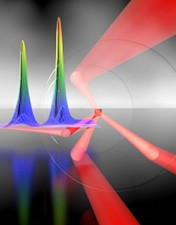Physical Society Colloquium
Optical Multidimensional Coherent Spectroscopy
JILA, NIST and University of Colorado Boulder
The concept of multidimensional Fourier transform spectroscopy originated
in NMR where it enabled the determination of molecular structure. In either
NMR or optics, a sample is excited by a series of pulses. The key concept
is to correlate what happens during multiple time periods between pulses by
taking a multidimensional Fourier transform. The presence of a correlation,
which is manifest as an off-diagonal peak in the resulting multidimensional
spectrum, indicates that the corresponding resonances are coupled.
 Migrating
multidimensional Fourier transform spectroscopy to the infrared and visible
regimes is difficult because of the need to obtain full phase information about
the emitted signal and for the phase difference between the excitation pulses
to be stable and precisely incremented. I will give an introduction to optical
two-dimensional coherent spectroscopy and then present our use of it to study
a potassium vapor and excitonic resonances in semiconductors. The atomic vapor
provides a simple well understood system for which the two-dimensional spectrum
can be calculated. However, the presence of inter-atomic interactions are
also revealed as unexpected peaks. By extending the technique into a third
dimension, it is possible to determine the Hamiltonian. In semiconductors,
our results show that many-body effects dominate the light-matter interaction
for excitons in semiconductors and provide a rigorous and quantitative test
of the theory.
Migrating
multidimensional Fourier transform spectroscopy to the infrared and visible
regimes is difficult because of the need to obtain full phase information about
the emitted signal and for the phase difference between the excitation pulses
to be stable and precisely incremented. I will give an introduction to optical
two-dimensional coherent spectroscopy and then present our use of it to study
a potassium vapor and excitonic resonances in semiconductors. The atomic vapor
provides a simple well understood system for which the two-dimensional spectrum
can be calculated. However, the presence of inter-atomic interactions are
also revealed as unexpected peaks. By extending the technique into a third
dimension, it is possible to determine the Hamiltonian. In semiconductors,
our results show that many-body effects dominate the light-matter interaction
for excitons in semiconductors and provide a rigorous and quantitative test
of the theory.
Ref: S.T. Cundiff and S. Mukamel, “Optical Multidimensional Coherent
Spectroscopy”, Physics Today 66(7), 44 (July 2013).
Friday, September 13th 2013, 15:30
Ernest Rutherford Physics Building, Keys Auditorium (room 112)
|
 Migrating
multidimensional Fourier transform spectroscopy to the infrared and visible
regimes is difficult because of the need to obtain full phase information about
the emitted signal and for the phase difference between the excitation pulses
to be stable and precisely incremented. I will give an introduction to optical
two-dimensional coherent spectroscopy and then present our use of it to study
a potassium vapor and excitonic resonances in semiconductors. The atomic vapor
provides a simple well understood system for which the two-dimensional spectrum
can be calculated. However, the presence of inter-atomic interactions are
also revealed as unexpected peaks. By extending the technique into a third
dimension, it is possible to determine the Hamiltonian. In semiconductors,
our results show that many-body effects dominate the light-matter interaction
for excitons in semiconductors and provide a rigorous and quantitative test
of the theory.
Migrating
multidimensional Fourier transform spectroscopy to the infrared and visible
regimes is difficult because of the need to obtain full phase information about
the emitted signal and for the phase difference between the excitation pulses
to be stable and precisely incremented. I will give an introduction to optical
two-dimensional coherent spectroscopy and then present our use of it to study
a potassium vapor and excitonic resonances in semiconductors. The atomic vapor
provides a simple well understood system for which the two-dimensional spectrum
can be calculated. However, the presence of inter-atomic interactions are
also revealed as unexpected peaks. By extending the technique into a third
dimension, it is possible to determine the Hamiltonian. In semiconductors,
our results show that many-body effects dominate the light-matter interaction
for excitons in semiconductors and provide a rigorous and quantitative test
of the theory.